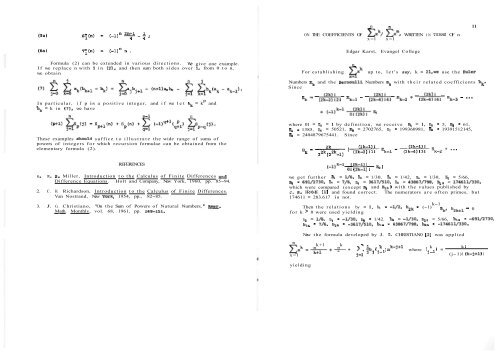Vol. 4 No 1 - Pi Mu Epsilon
Vol. 4 No 1 - Pi Mu Epsilon
Vol. 4 No 1 - Pi Mu Epsilon
Create successful ePaper yourself
Turn your PDF publications into a flip-book with our unique Google optimized e-Paper software.
+ (-llk-l(2;-6;161ON THE COEFFICIENTS OFn 11EXk/ gx=lX m # WRITTEN IN TERMS OF nx=lEdgar Karst, Evangel CollegeFormula (2) can be extended in various directions. We give one example.If we replace n with j in (2), and then sum both sides over j, from 0 to n,we obtainFor establishingnup to, let's say, k = 21,we use the EulerIn particular, if p is a positive integer, and if we let a, = k p andbk = k in (7). we haveNumbers Ek and the ~ernoulli Numbers Bk with their related coefficients bk-Since2k 1 2k I 2k 1Ek= (2;-2;121 Ek-l - (2;-4;141 Ek-2 +Ek-3 - ---These examples should suffice to illustrate the wide range of sums ofpowers of integers for which recursion formulae can be obtained from theelementary formula (2).where 01 = Eo = 1 by definition, we receive = 1, E, = 5, & = 61,l& = 1385, Eg = 50521, Ee = 2702765, E, = 199360981, !& = 19391512145,= 2404879675441. SinceREFERENCES1. K. S. Miller, Introduction to the Calculus of Finite DifferencesDifference Equations. Holt and Company, New York, 1960, pp. 85-94.2. C. H. Richardson, Introduction to the Calculus of Finite Differences.Van <strong>No</strong>strand, New York, 1954, pp., 82-85.3. J. G. Christiano, "On the Sum of Powers of Natural Numbers, " -.Math. Monthly, vol. 68, 1961, pp. 149-151. -2k-1 10; (2k-;I GI1we get further = 1/6, Ba = 1/30, 63 = 1/42, B, = 1/30, Bs = 5/66,= 691/2730, B, = 7/6, Be = 3617/510, Eg = 43867/798, Bio = 174611/330,which were compared (except Bo and Bin) with the values published byJ. S. FRAME [l] and found correct. The numerators are often primes, but174611 = 283.617 is not.k-1Then the relations by = 1, t>i = -1/2, bZk = (-1) Bk, bZk+, = 0for k > 0 were used yieldingh, = 1/6, b, = -1/30, = 1/42. & = -1/30, = 5/66, b13 = -691/2730,bl, = 7/6, big = -3617/510, ble = 43867/798, bgo = -174611/330.<strong>No</strong>w the formula developed by J. G.CHRISTIAN0 [2] was appliedx=lk+lkk k 1+ 5, ( nk-j+l where =j=2 (j-1) 1 (k-j+1) 1yielding
















